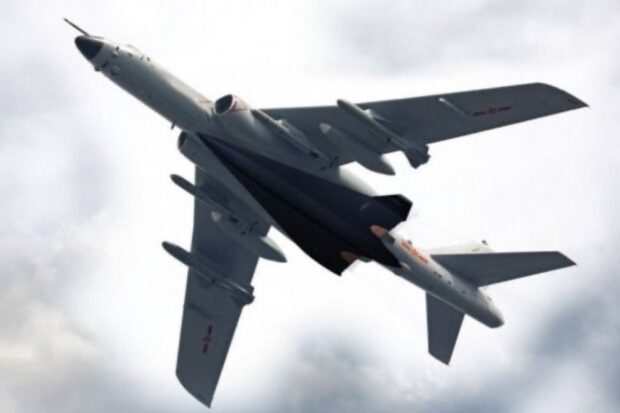Recently, social media users have shared photos of a Chinese N-6H bomber in flight. This bomber, an adapted Soviet Tu-16 that is produced in China, had a WZ-8 jet drone attached to its undercarriage. The exact context of these photos remains unclear, such as whether the WZ-8 drone is operational, or if this was simply a test flight for the bomber or drone.
What’s intriguing is that these photos surfaced exactly a year after an alleged leak of a classified US Intelligence report. This document suggested that China’s People’s Liberation Army [PLA] has deployed a squadron of supersonic unmanned aerial vehicles [UAVs] featuring the delta-shaped WZ-8.
The classified document suggests that the bomber carries the WZ-8, transporting it well beyond the surveillance zone before returning to its base. The WZ-8 then accelerates to Mach 3, cruising at an altitude of 100,000 feet over the target area before landing at a nearby airstrip. The document also implies that its sensor suite might include synthetic aperture radar and an electro-optical sensor for daylight operations.
Though the authenticity of this supposed National Geospatial Intelligence Agency document remains uncertain, it seems to be part of a series of recent classified leaks. It’s noteworthy that the Federal Bureau of Investigation apprehended Airman First Class Jack Teixeira on April 14, accused of sharing classified documents via social media.
‘Parade’ Drone
Despite the scant visibility of China’s jet drone, the WZ-8, it has made sporadic appearances ever since its introduction in 2021. The aircraft was initially showcased in the car park of the Zhuhai Air Show, later making an appearance at the Changchun Air Show in the fall of 2022.
What’s intriguing is that during these displays, even though the Chinese only exhibited the drone in a static show, they made audacious claims regarding its capabilities. It was touted with a suggested top speed of 3700 km/h, a maximum range of 8,000 kilometers, and was billed as a tool for intelligence gathering or targeting US Navy vessels in the Pacific.
Since its unveiling, the WZ-8 drone has been occasionally displayed at various events. It has even been spotted in satellite images of China’s military bases. However, no reports have emerged to date regarding the testing of this drone.
About WZ-8
The WZ-8 is a high-speed, high-altitude reconnaissance drone developed by the People’s Republic of China. It is designed for strategic reconnaissance missions, providing valuable intelligence in real time. The drone is launched from an aircraft and returns to Earth via parachute after completing its mission.
The exact dimensions of the WZ-8 are not publicly disclosed due to its classified nature. However, it is known to be a relatively compact drone, designed to be carried and launched from a bomber aircraft. Its sleek, aerodynamic design allows it to reach high speeds and altitudes.
Technically, the WZ-8 is equipped with a unique propulsion system. It uses a combined cycle engine, which is a combination of a turbojet and a ramjet engine. This allows the drone to fly at subsonic speeds during takeoff and landing, and then switch to supersonic speeds during flight. The drone is also equipped with advanced avionics and sensors for its reconnaissance missions.
The WZ-8’s drive system is unique in that it doesn’t take off from a runway like traditional drones. Instead, it is launched from an aircraft, which allows it to start its mission at high altitudes and speeds. After completing its mission, the drone returns to Earth via parachute.
The operational range of the WZ-8 is another closely guarded secret. However, it is known that the drone is capable of operating at very high altitudes, which allows it to cover large areas during its reconnaissance missions. The drone’s combined cycle engine also allows it to stay in the air for extended periods, increasing its operational range.
How do Tu-16 and WZ-8 Work Together?
It’s important to note that the N-6H bomber itself doesn’t directly launch the WZ-8 drone. Instead, the bomber acts as a carrier, transporting the drone to the launch point. The WZ-8 drone is mounted on the underside of the N-6H bomber. The drone is attached to a pylon on the bomber’s fuselage, securely fastened and ready for deployment. When the bomber reaches the desired launch point, the WZ-8 drone is dropped from the bomber. This is done by releasing the drone from the pylon, allowing it to fall freely for a short distance.
Once the drone is clear of the bomber, its rocket motor ignites. This propels the drone upwards and forwards, allowing it to reach high altitudes and speeds. The WZ-8 drone is capable of reaching speeds of up to Mach 3 and altitudes of up to 40,000 feet.
After the drone completes its mission, it returns to a predetermined location. The WZ-8 drone is not designed to land back on the N-6H bomber. Instead, it uses a parachute system to slow its descent and land safely back on the ground.
Top Photo: Twitter/X
Source: Bulgarian Military





